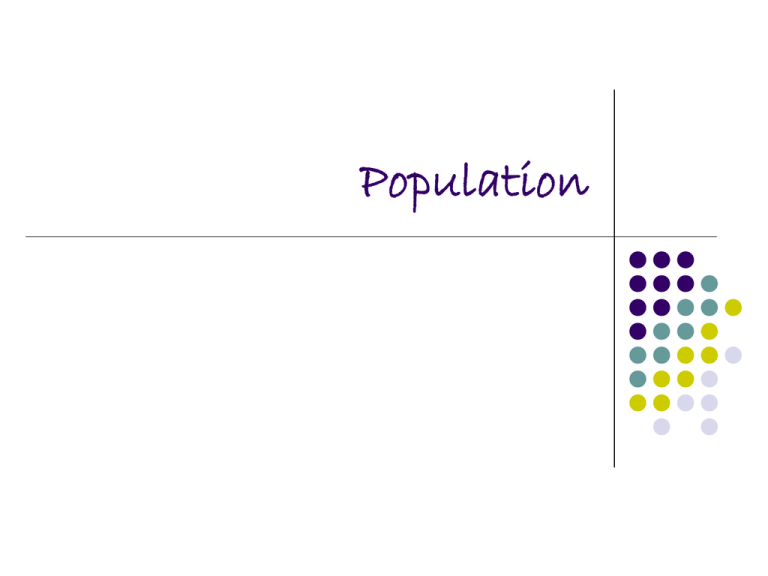Population Density
advertisement

Population Many Ways of Measuring Population: Population Density measure of total population relative to land size arithmetic population density World Population Density •Where is population the densest? •What factors might influence population density? Physiologic Population Density – number of people per unit area of agriculturally productive land Toronto, Canada 5,113,149 people 8.3 per square mile 168 per square mile Only five percent of Canada’s land is arable Moving northward, the land is frozen and unfarmable. Arithmetic Density: 32 per square mile Physiological Density: 1, 601 per square mile Population Distribution – Descriptions of locations on the Earth’s surface where individuals or groups (depending on the scale) live. Dot Map of World Population – On this map, one dot represents 100,000 people World Population Distribution and Density East Asia - ¼ of world population here South Asia - bound by the Himalayas and a desert in Pakistan Europe - population is concentrated in cities North America - megalopolis Megalopolis: Roughly Boston through Washington D.C. Populations are falling in some parts of the world. How will Figure 2.5 look different 50 years from now? If you were updating this lesson in 50 years, where would the largest population clusters in the world be? A Population Bomb? Malthus (early 1800s) Food production increased at an arithmetic ratio (1, 2, 3...) while population increased at an exponential ratio (1, 2, 4, 8...). Man is incapable of controlling his own numbers, so natural calamities such as floods and epidemics serve to control/reduce his numbers. Ehrlich (1960s) warned of a population bomb because the world’s population was outpacing food production. radical action is needed to limit the overpopulation. World Population Growth – Rate of natural increase (does not take into account immigration and emigration). Today, the pace of world population growth is slowing. Where have Total Fertility Rates (TFRs) fallen below replacement level and why? Population Growth in India Significant demographic variations occur within countries. In India, growth rates are higher in the east and northeast. What could explain regional variations? Why do Growth Rates Vary in India? 1960s population planning program 1970s country began forced sterilization program for men with 3 or more children. 22.5 million men were sterilized. 2004 state of Uttar Pradesh began guns for sterilization program. Today, most states use advertising and persuasion to lower birth rates. Maharashtra, India. A sign reads “free family planning sterlization operation” closed in 1996. The Demographic Transition in Great Britain Studied the change in birth rates, death rates, and natural growth rates over the course of British industrialization. Found a transition occurred when death rates decline and then birth rates decline, resulting in a low or sustained growth rate. World Birth Rate – number of births in a year per 1,000 people. World Mortality Rate – number of deaths in a year per 1,000 people. The Demographic Transition The Demographic Transition Stage 1: Low Growth Stage 2: High Growth Stage 3: Moderate Growth Stage 4: Low Growth or Stationary Stationary population level (SPL)? Population Composition Population Composition is concerned with: Gender distribution Age distribution within a country, region, or place. Population Pyramids – Charts that show the percentages of each age group in the total population, divided by gender. For poorer countries, the chart is shaped like a pyramid. Infant mortality rates are high, life expectancy is shorter. In poorer countries, Infant Mortality Rates are usually high, which is reflected in the pyramid shape. In poorer countries, Life Expectancy is usually shorter, which is also reflected in the pyramid shape. Affect of AIDS on population pyramid for South Africa. Predicted population for 2035, without and with AIDS. With AIDS, looks like a population “chimney.” AIDS is leaving large numbers of AIDS orphans. AIDS is creating large numbers of AIDS care-givers. Drawing by a Pokot boy in Kenya, the drawing shows him working in the fields and taking care of his family cattle in order to assist his sick family members. Population Pyramids – Charts that show the percentages of each age group in the total population, divided by gender. For wealthier countries, the chart is shaped like a lopsided vase. Population is aging, TFRs are declining. Age Structure of a Population The populations of many countries are aging. - eg. Europe - eg. Japan Photo credit: H.J. de Blij Bordeaux, France Aging Populations To replace the population, TFR must be 2.1. - TFR in Bologna, Italy is 0.8 Why are women having fewer children? What are the impacts of an aging population on a country? What are the “solutions” to an aging population? Longer Life Expectancies typically mean higher rates of chronic diseases. In the United States, the national infant mortality rate (IMR) is 7.0. That number represents an average for the country. Think about the differences in IMR in the United States across regions, ethnicities, social classes, and other sectors. Government Population Policies Expansive Population Policies - Encourages population growth. Eugenic Population Policies - Favors one racial or cultural sector over others. Restrictive Population Policies - range from toleration of unapproved birth control to outright prohibition of large families. China’s One Child Policy What are some of the limitations, unintended consequences, and contradictions found in government policies toward population growth? When studying government policies on population, one of the most important things to remember is unintended consequences. Choose one country in the world where women have little access to education and are disempowered. Consider the previous section of the chapter on age composition, and determine how restrictive population policies in this country will alter the population composition of the country.








